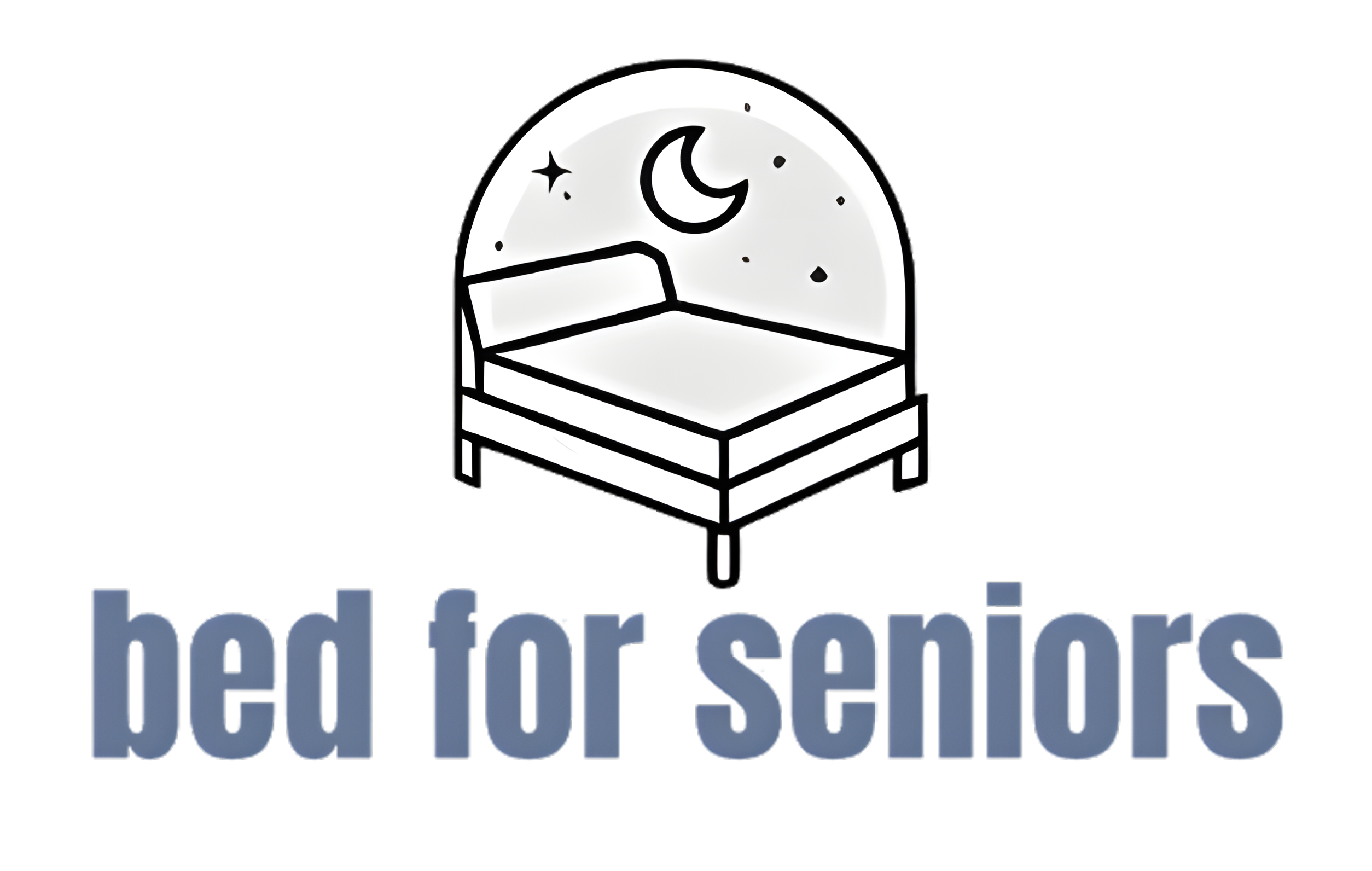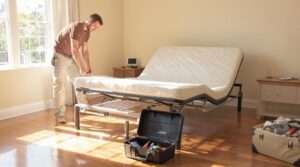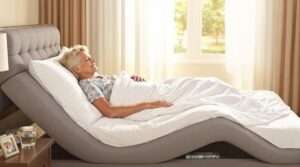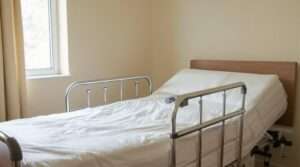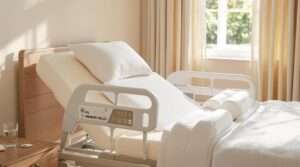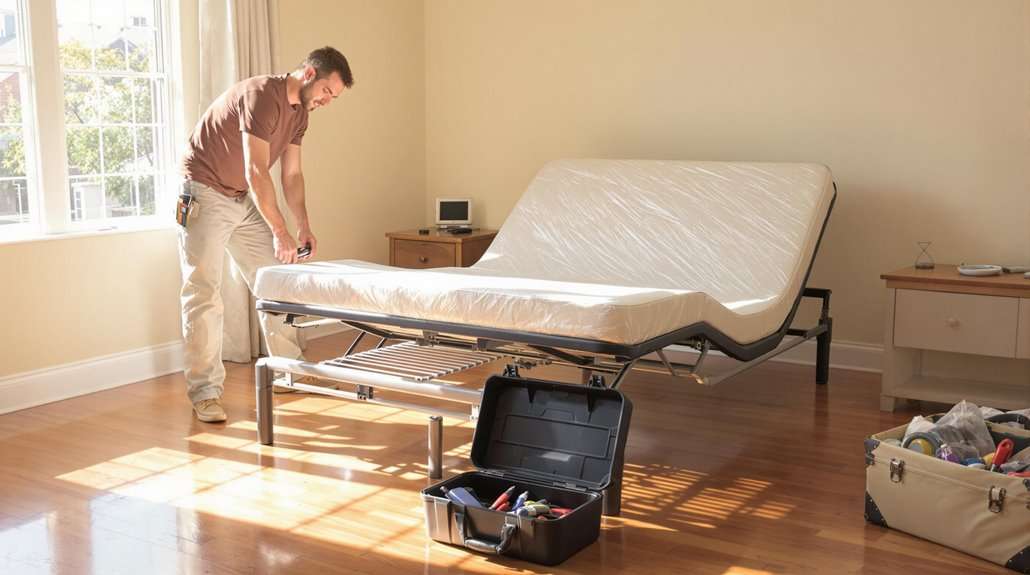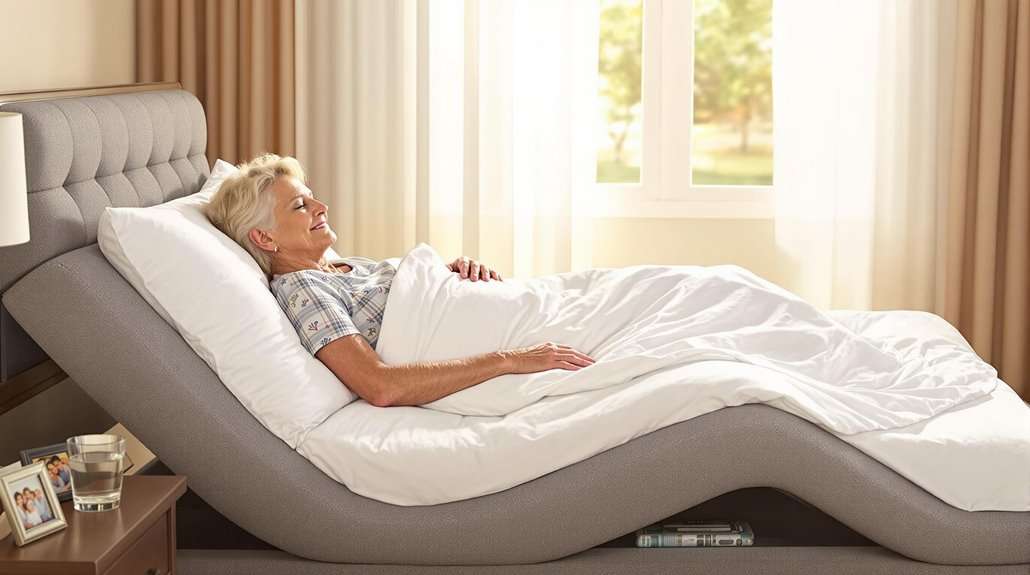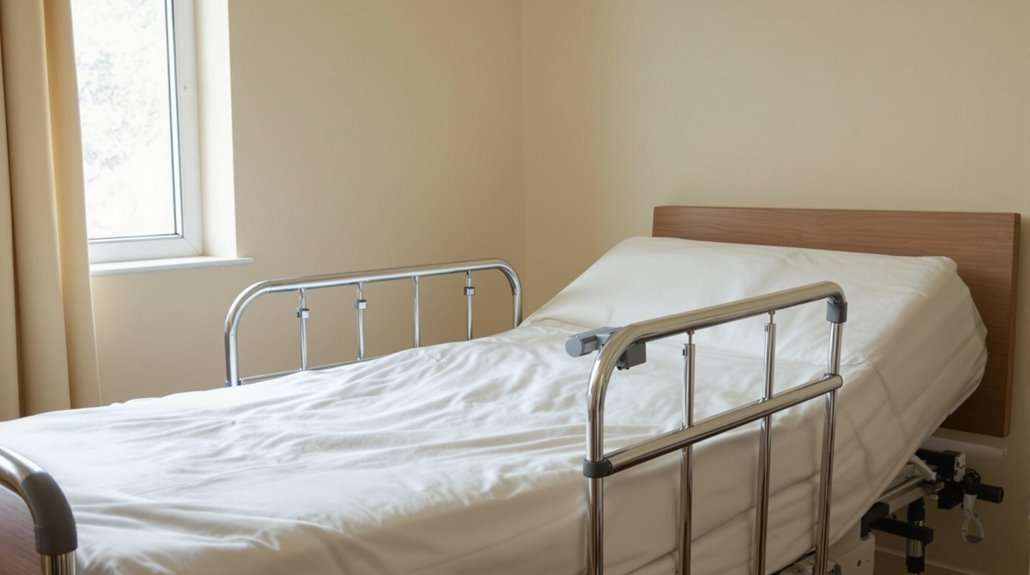Elderly beds are specialized medical furniture designed to enhance comfort, safety, and independence for aging individuals. These beds feature adjustable positioning capabilities, secure side rails, and therapeutic functions that support various health needs. Common types include adjustable beds with motorized controls, low-profile beds for fall prevention, and profiling beds for specific medical conditions. Most models incorporate height adjustment mechanisms, making transfers safer for both seniors and caregivers. Advanced features may include pressure relief systems, ergonomic designs, and emergency functions. Understanding the various options and features will help determine the most suitable bed for specific care requirements.
📋✅
- Elderly beds are specialized medical beds designed with adjustable features, safety rails, and therapeutic positioning to support aging individuals’ comfort and care.
- These beds include height adjustment mechanisms, making it easier for seniors to get in and out safely while helping caregivers assist them.
- They come in various types like adjustable, profiling, and low-profiling beds, each serving specific needs such as respiratory issues or fall prevention.
- Most elderly beds feature electric controls for position adjustments, side rails for protection, and compatibility with specialized mattresses for pressure relief.
- They help maintain proper body alignment, reduce fall risks, and support various medical conditions while enabling independent living for seniors.
Understanding Types of Elderly Beds
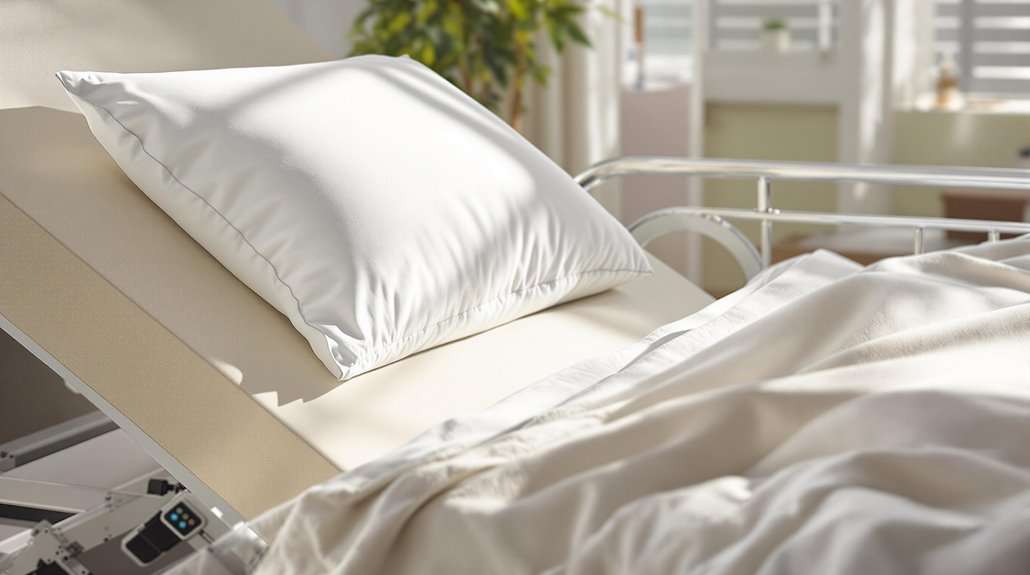
The selection of an appropriate elderly bed plays an essential role in ensuring comfort, safety, and independence for aging individuals. Several distinct types of elderly beds are available, each designed to address specific needs and user preferences.
Adjustable beds feature motorized components that allow for customized positioning, enhancing bed comfort through various elevation options for both back and leg support. These beds often include programmable settings to save preferred positions, making daily adjustments effortless for users or caregivers. The dual adjustment features allow couples to customize their individual sides without disturbing their partner’s sleep. Medium-firm mattresses like the Saatva Rx are particularly beneficial for these beds, as they provide optimal spinal alignment while maintaining comfort.
Profiling beds combine height adjustment capabilities with specialized features like Trendelenburg positioning, particularly beneficial for those with respiratory or circulatory concerns. These medical-grade beds incorporate safety rails and promote independence by facilitating easier bed entry and exit.
For those at higher risk of falls, low profiling beds provide an ultra-low sleeping position near ground level, maximizing safety while maintaining essential functionality. These beds typically include protective side rails and adjustable height features. Additionally, hybrid mattresses can be integrated with any of these bed types, offering targeted pressure relief through their combined foam and coil construction, ensuring ideal support for various sleeping positions.
Key Features and Functions
Modern elderly beds incorporate essential safety features including adjustable side rails and user-friendly controls that enhance both patient security and caregiver effectiveness. The height adjustment mechanisms allow for safe transfers while reducing strain on caregivers during routine care activities. Therapeutic position settings enable customized comfort and support medical needs through various preset positions, including the crucial cardiac chair position for respiratory and circulatory benefits. Specialized mattresses provide enhanced pressure relief to help prevent bedsores and discomfort for aging bodies. Electric beds with motorized features offer maximum convenience for elderly individuals who require frequent position adjustments throughout the day.
Safety Rails and Controls
Safety rails and controls represent essential components of elderly beds, serving multiple critical functions that enhance both safety and mobility for senior patients. Different bed rail types, including full-length, half-length, and adjustable options, provide customized solutions to meet individual needs. Safety rail benefits extend beyond fall prevention to include enhanced independence and improved caregiver assistance. Professional installation ensures that fixed bed rails are properly secured for optimal protection. The ability to provide restful sleep reduces anxiety about falls in elderly patients and enhances overall comfort.
| Safety Feature | Primary Function |
|---|---|
| Full-Length Rails | Complete fall protection along entire bed length |
| Adjustable Controls | Customizable height and positioning settings |
| Padded Surfaces | Enhanced comfort and injury prevention |
| Folding Mechanisms | Easy access for transfers and care delivery |
| Storage Solutions | Convenient access to essential items |
Modern safety rails incorporate ergonomic designs that facilitate proper patient positioning while reducing entrapment risks. These features work in conjunction with electronic controls to allow seamless adjustments of bed height and position. Healthcare providers particularly value the dual functionality of safety rails, which serve both as protective barriers and mobility aids. When properly implemented, these systems considerably reduce fall-related injuries while promoting patient autonomy. Regular maintenance and proper adjustment guarantee ideal performance and compliance with healthcare facility regulations.
Height Adjustment Mechanisms
Height adjustment mechanisms constitute one of the most critical components in elderly beds, offering versatile functionality that enhances both patient comfort and caregiver efficiency. These mechanisms range from fixed-height designs to sophisticated electric systems controlled via remote, with height ranges typically spanning from 12.5 to 28 inches to accommodate various needs.
The primary height adjustment benefits include enhanced safety during transfers and improved accessibility for both users and caregivers. Electric adjustment systems enable smooth shifts between positions, allowing beds to be lowered for safe entry and exit or raised for ideal nursing care. This flexibility greatly reduces the risk of falls while promoting user independence in daily activities. The incorporation of high-density foam cushions provides additional comfort during position adjustments. Transfer Master beds have been specifically designed to maintain this independence while seamlessly integrating into home environments.
These mechanisms feature either single or dual motors, providing customizable positioning options that adapt to individual requirements. The ability to adjust bed height supports proper ergonomics for caregivers during assistance tasks and enables residents to maintain autonomy in managing their bed positions. When combined with stable flooring and appropriate mattress systems, height-adjustable beds create an ideal environment for both comfort and safety, ultimately contributing to improved quality of life for elderly individuals.
Therapeutic Position Settings
Understanding therapeutic position settings is paramount in elderly beds, as these adjustable configurations serve both medical necessity and patient comfort. Modern elderly beds incorporate multiple positioning techniques that can be adjusted to meet specific medical requirements while guaranteeing ideal patient care. Continuous monitoring and assessment of skin integrity is crucial during prolonged bed rest.
Key positions include Fowler’s position, with adjustable angles between 30-90 degrees, particularly beneficial for respiratory function and digestion. The Semi-Fowler’s position, set at 30 degrees, supports patients with cardiac conditions, while High Fowler’s position aids elderly individuals with breathing difficulties. These positions maintain neutral alignment of the head, neck, and spine, which is crucial for patient safety. For pressure relief, the bed can be adjusted to support lateral positioning, where patients lie on their side, or supine positioning for back support.
These therapeutic settings are enhanced through supportive devices like pillows and wedges, which help maintain proper body alignment and prevent pressure injuries. Regular repositioning every 2-4 hours is essential for preventing complications, particularly in long-term care settings. The bed’s ability to achieve various positions helps caregivers implement effective positioning techniques while minimizing physical strain. This versatility in positioning options guarantees that elderly residents receive appropriate support for their specific medical conditions while maintaining comfort throughout their care.
Health Benefits for Seniors
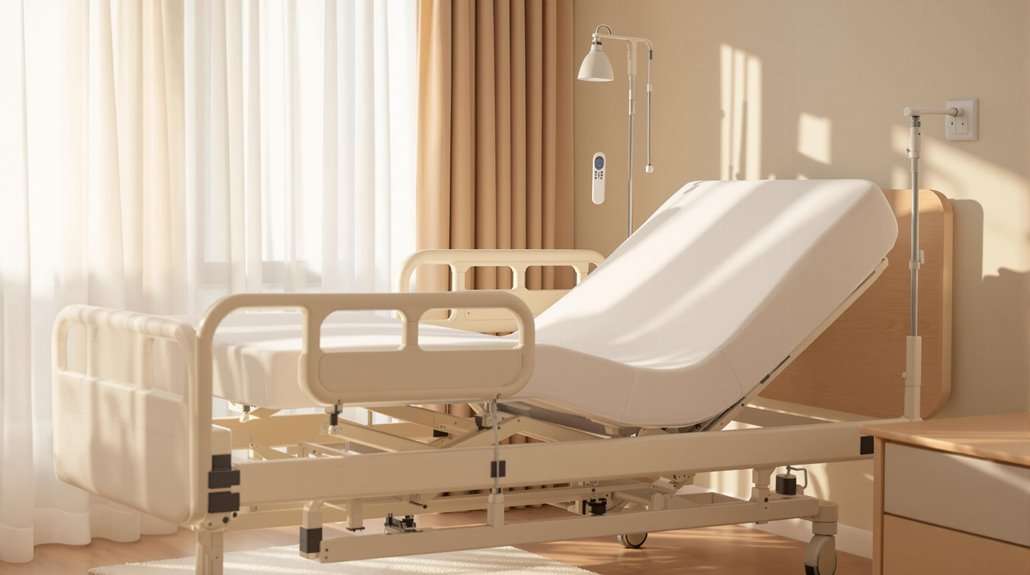
When considering the essential components of elderly care, specialized elderly beds offer numerous notable health benefits that can greatly improve seniors’ quality of life. As essential mobility aids, these beds meaningfully reduce fall risks through adjustable low heights and provide vital caregiver support through customizable positioning features.
The physical benefits are extensive, including reduced joint pain through frequent repositioning capabilities and improved lower extremity strength through proper mobilization support. Studies show that just 10 days of bed rest can lead to significant muscle weakness in older adults. The beds’ elevation features help manage leg swelling while promoting safe, independent movement. Additionally, these specialized beds address specific medical conditions such as GERD, sleep apnea, and chronic pain through strategic positioning options. Studies indicate that home care services significantly improve physical health maintenance and cognitive function in elderly individuals.
Beyond physical advantages, elderly beds contribute greatly to mental and emotional well-being. They reduce anxiety and stress by providing comfortable positions that facilitate easier breathing and movement. The enhanced independence these beds offer boosts confidence and encourages active participation in daily activities. For long-term care, these specialized beds play an essential role in preventing disability, supporting home care implementation, and reducing hospitalization risks through their extensive safety features and adjustability options.
Safety Measures and Design Elements
Safety stands paramount in elderly bed design, with multiple critical features working together to protect seniors from potential hazards and injuries. The ideal bed height allows seniors to place their feet flat on the floor while sitting, with knees aligned with hips, promoting both bed comfort and safer transfers. Regular bed height assessment helps maintain optimal positioning over time. Adjustable height features accommodate both patient needs and caregiver assistance requirements, enhancing overall sleep quality.
Proper bed rail implementation serves dual purposes: providing support for repositioning while preventing dangerous entrapment situations. This is achieved through appropriate mattress sizing and strategic rail positioning. The bedroom environment requires careful consideration, with motion-sensor lighting and accessible bedside tables reducing the need for risky nighttime movements. Using lightweight bedding materials can prevent seniors from becoming entangled while getting in or out of bed.
Additional safety elements include anti-wandering devices, bedside commodes, and strategically placed floor mats. The removal of potential hazards such as throw rugs and exposed electrical cords further reduces fall risks. Well-organized storage solutions, including properly positioned closet rods and shelves, minimize the need for overreaching or unsafe movements. These design elements work cohesively to create a secure sleeping environment that prioritizes both safety and independence.
Choosing the Right Elderly Bed
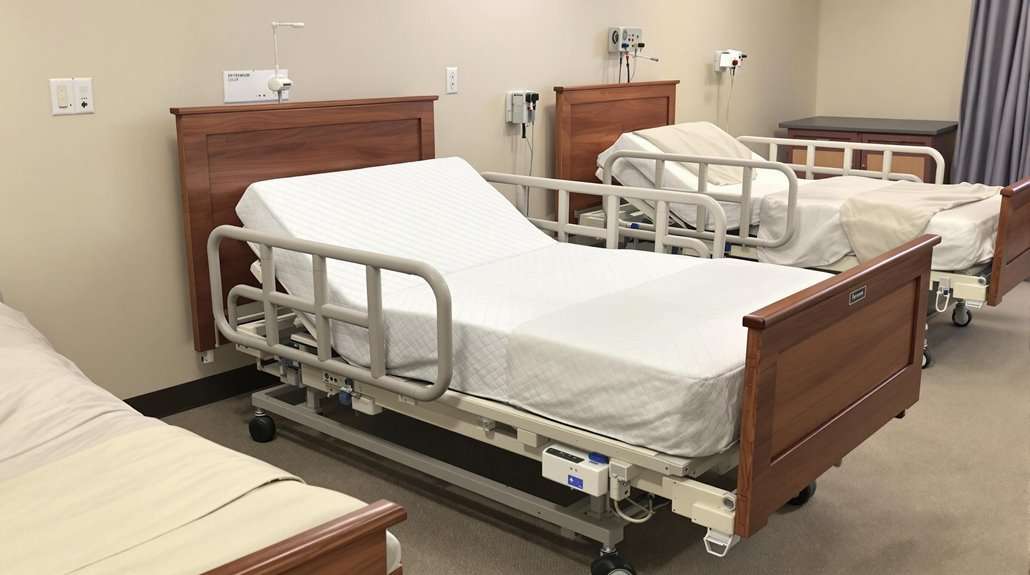
When selecting an elderly bed, careful consideration must be given to the available room dimensions and ideal placement to guarantee both accessibility and comfort for the user and caregivers. Important safety features, including sturdy side rails, emergency lowering functions, and proper height adjustability, should take precedence in the decision-making process. While budget constraints may influence choices, it’s vital to prioritize fundamental features that directly impact the user’s well-being and safety rather than focusing on non-essential luxury additions. TiMOTION’s commitment to energy efficient design ensures these beds operate sustainably while maintaining optimal performance for long-term care needs.
Room Size and Placement
Proper room size and bed placement play three critical roles in guaranteeing the comfort, safety, and accessibility of an elderly person’s sleeping area. When determining room dimensions, caregivers must carefully measure the space while accounting for the bed’s width, length, and any additional components like headboards or footboards. This initial assessment guarantees adequate clearance for mobility aids and caregiver access.
The layout optimization process requires strategic bed placement that considers both daily care routines and emergency scenarios. Essential factors include positioning bed controls within easy reach, maintaining clear evacuation routes, and guaranteeing sufficient space for caregivers to assist from either side. For care facilities, room configurations must adhere to specific size requirements while maintaining dignity and safety standards.
To maximize available space, consider adjustable or profiling beds that offer flexibility in smaller rooms. Wall-mounted furniture can preserve floor space, while proper lighting placement reduces accident risks. When planning the layout, assess doorway and hallway dimensions to facilitate smooth bed delivery and potential future equipment installations. This thorough approach to room planning creates an environment that supports both practical care delivery and resident comfort.
Safety Features Matter Most
The paramount concern in selecting an elderly bed lies in its integrated safety features, which form the foundation of secure and dignified care. Proper emergency preparedness and user education regarding these features are vital for both caregivers and residents.
| Safety Feature | Important Function |
|---|---|
| Bed Rails | Prevents falls while providing mobility support |
| Gap Protection | Eliminates dangerous spaces between mattress and rails |
| Height Adjustment | Enables safe transfers and reduces fall risks |
| Support Systems | Assists caregivers during patient transfers |
| Regulatory Compliance | Guarantees adherence to safety standards |
When evaluating safety features, careful consideration must be given to the specific needs of elderly individuals, particularly those with cognitive impairments or physical limitations. Proper installation and regular assessment of safety components are essential, as is the implementation of supplementary measures such as non-slip surfaces and proper mattress fitting. Healthcare providers and family caregivers must maintain vigilant monitoring of these features, adjusting them as needed based on the resident’s changing conditions. The integration of ergonomic designs and comfort features, while maintaining strict safety standards, creates an environment that promotes both security and independence for elderly residents.
Budget Vs Essential Features
Building upon the foundation of safety features, selecting an elderly bed requires careful consideration of both financial constraints and necessary functionalities. When evaluating budget priorities, it’s essential to recognize that while full-electric beds offer maximum convenience, semi-electric alternatives can provide a cost-effective middle ground without compromising fundamental needs.
Making informed feature trade offs requires careful assessment of individual requirements. For those needing frequent adjustments, investing in motorized functionality may prove more economical long-term despite higher initial costs. Height adjustment capabilities, ergonomic design, and user-friendly controls often justify additional expenditure by promoting independence and reducing caregiver strain.
Healthcare professionals can provide valuable guidance in prioritizing features based on specific medical conditions. For individuals with severe health needs, insurance coverage for hospital beds may offset costs considerably. Consider practical solutions like bed rental for temporary requirements or split-king configurations for couples requiring different adjustment capabilities.
When balancing budget constraints against essential features, focus on core functionalities such as adjustability, mattress compatibility, and necessary safety components. Additional features like pre-programmed positions and specialized mattresses should be evaluated based on their direct contribution to the user’s comfort and well-being.
Specialized Care Applications
Throughout healthcare settings, specialized elderly beds serve distinct medical needs through various applications designed for specific patient conditions and care requirements. Bariatric beds feature reinforced structures and wider dimensions to safely accommodate patients requiring additional support, while long-term care beds incorporate multiple position adjustments and pressure-relieving surfaces for those with chronic conditions.
For intensive care scenarios, specialized beds integrate advanced monitoring systems and emergency functions, including CPR capabilities and essential sign tracking. These beds utilize powerful motors for precise adjustments, ensuring reliable operation during critical care delivery. The incorporation of full electric controls enables healthcare providers to make necessary position changes efficiently.
Safety-focused features for elderly mobility include adjustable height settings, secure side rails, and locking mechanisms to prevent falls. Smart technology integration, such as pressure sensors and real-time monitoring systems, enhances patient safety and care quality. The emphasis on pressure relief through specialized mattress systems helps prevent complications like bedsores, particularly significant for patients with limited mobility or those requiring extended bed rest.
Home Setup and Maintenance
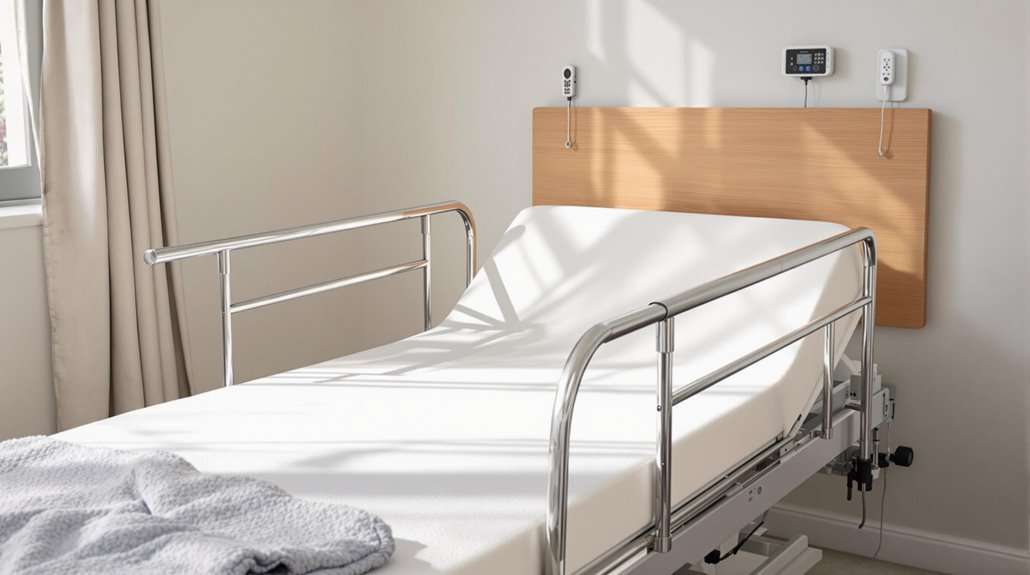
When setting up elderly beds for home care, proper installation and ongoing maintenance play crucial roles in ensuring patient safety and comfort. Medicare Part B coverage often assists with the acquisition of these beds as durable medical equipment when prescribed by a physician. Before installation, careful consideration must be given to home modifications, ensuring adequate doorway clearance and room space for caregiver accessibility.
Regular maintenance protocols involve systematic inspection of all components, including headboards, footboards, and side rails. Electrical connections require careful monitoring, particularly checking cables for wear and secure connections. The bed’s mechanical integrity depends on routine tightening of bolts and screws, along with appropriate lubrication as specified in the operator’s manual.
Safety measures include verifying proper rail installation, checking caster functionality, and ensuring locking mechanisms operate effectively. For electric models, maintaining a functional emergency hand crank is essential. Daily cleaning procedures using mild detergent and warm water help maintain hygiene standards. Additionally, selecting appropriate bedding materials and positioning accessories contributes to patient comfort while facilitating proper care delivery. Strategic placement of overbed tables and essential items enhances both patient independence and caregiver efficiency.
Frequently Asked Questions
How Long Do Elderly Beds Typically Last Before Needing Replacement?
Elderly beds typically last 7-15 years, depending on mattress types and bed features. Regular maintenance of mechanical components and usage intensity considerably impact longevity, with institutional settings requiring more frequent replacements than home environments.
Can Medicare or Insurance Help Cover the Cost of Elderly Beds?
When push comes to shove, Medicare coverage typically pays 80% of approved elderly bed costs, while various insurance options may provide additional coverage. Pre-authorization and physician documentation of medical necessity are usually required.
What Certifications Should I Look for When Purchasing an Elderly Bed?
When purchasing elderly beds, prioritize products with CertiPUR-US for mattress safety, GREENGUARD Gold for air quality, and OEKO-TEX for non-toxic materials. These certifications guarantee ideal bed safety features across different mattress types.
Are Rental Options Available for Temporary Elderly Bed Needs?
Yes, rental services offer flexible, temporary solutions for elderly bed needs. These services provide various bed features, professional installation, and maintenance support, making them ideal for short-term care requirements or post-operative recovery situations.
How Much Space Is Needed Around the Bed for Proper Caregiver Access?
For ideal caregiver mobility and bed accessibility, maintain a minimum clearance of 30 inches around all sides of the bed, with primary pathways requiring 36 inches for safe movement and efficient care delivery.
Elderly beds represent essential medical equipment that significantly enhances senior care through specialized features like adjustable positioning, safety rails, and pressure relief systems. While the initial cost may seem prohibitive, the long-term benefits of reduced caregiver strain, improved patient comfort, and decreased risk of complications justify the investment. When properly selected and maintained, these specialized beds contribute substantially to both the quality of care and dignity of elderly individuals requiring extended bed rest or assistance.
